Foundations of Workplace Culture and Success in Philips Financial
VerifiedAdded on 2023/06/11
|8
|2291
|480
Essay
AI Summary
This essay provides an analysis of the organizational structure, workplace culture, leadership style, and bullying prevention strategies suitable for Philips Financial Services. The firm, owned by Nick Philips, faces challenges related to its diverse workforce and rapid expansion. The essay recommends a decentralized organizational structure with a clear chain of command and formalized jobs. It also emphasizes the importance of ethical leadership, behavior modeling, and skill-building techniques to foster a positive and ethical workplace culture. Furthermore, it addresses the causes of workplace bullying, such as abrupt organizational change and inadequate workplace policies, and suggests strategies for implementing a bullying prevention program, including regular policy reviews, training programs, and support systems. The aim is to create a more comfortable, respectful, and productive work environment within Philips Financial Services, enabling it to compete effectively with larger firms.
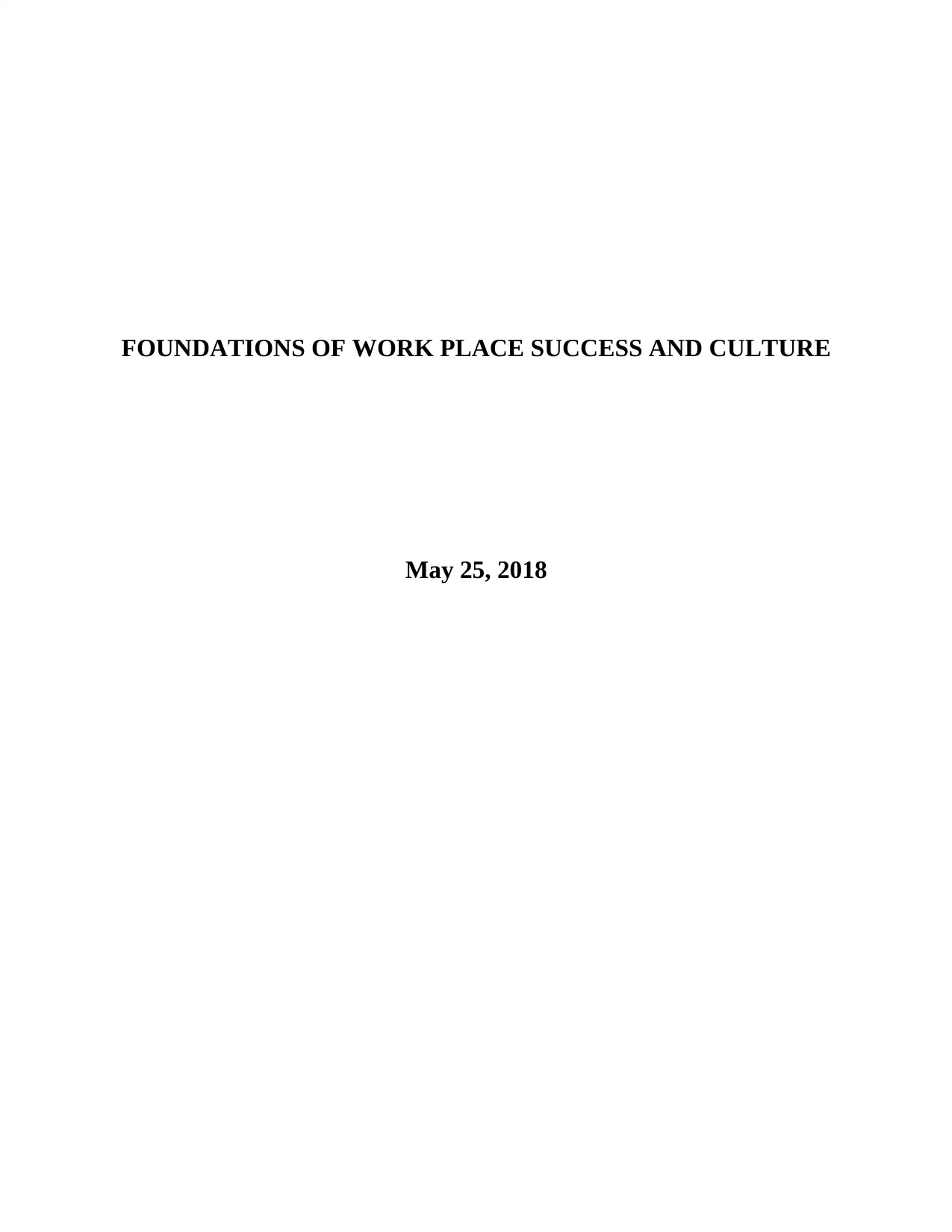
FOUNDATIONS OF WORK PLACE SUCCESS AND CULTURE
May 25, 2018
May 25, 2018
Paraphrase This Document
Need a fresh take? Get an instant paraphrase of this document with our AI Paraphraser
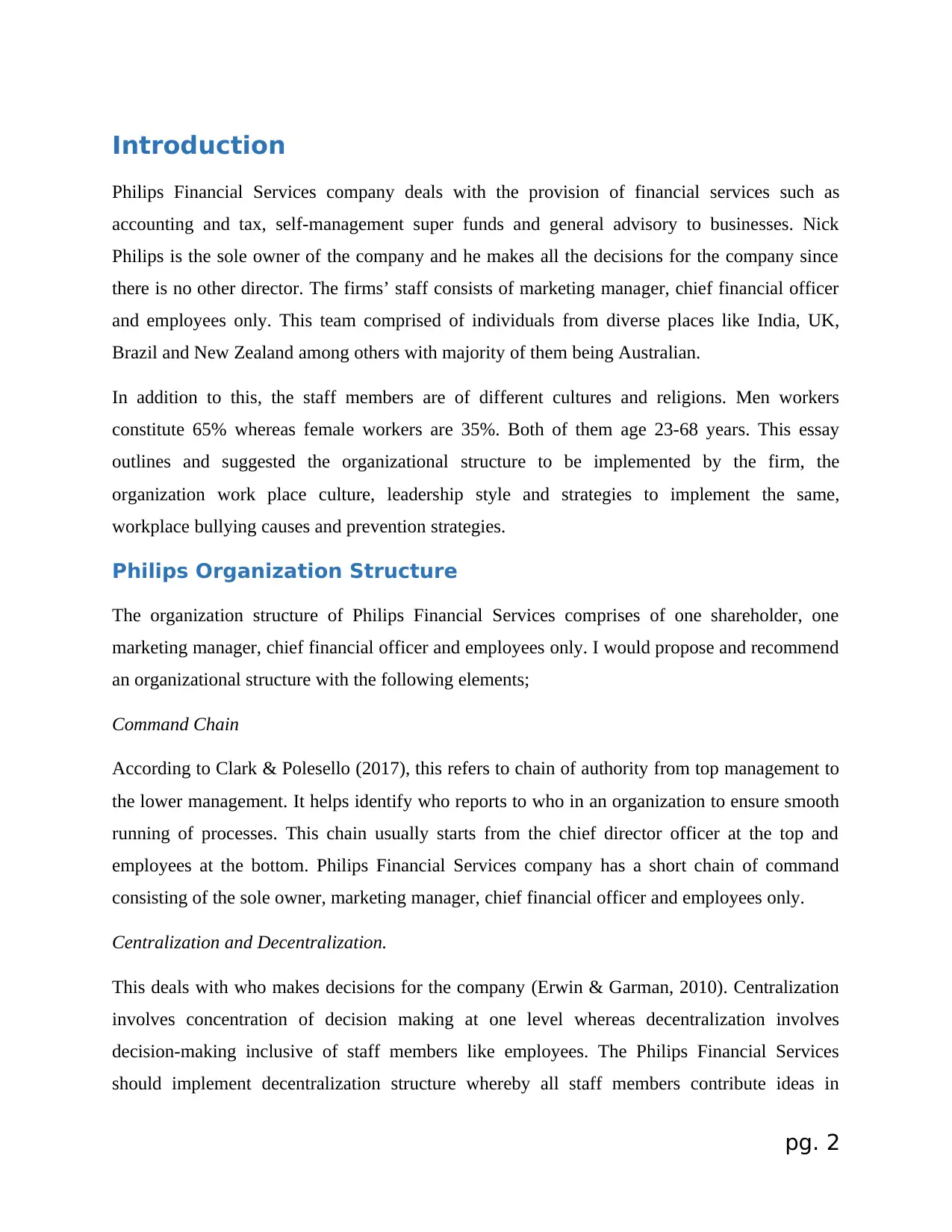
Introduction
Philips Financial Services company deals with the provision of financial services such as
accounting and tax, self-management super funds and general advisory to businesses. Nick
Philips is the sole owner of the company and he makes all the decisions for the company since
there is no other director. The firms’ staff consists of marketing manager, chief financial officer
and employees only. This team comprised of individuals from diverse places like India, UK,
Brazil and New Zealand among others with majority of them being Australian.
In addition to this, the staff members are of different cultures and religions. Men workers
constitute 65% whereas female workers are 35%. Both of them age 23-68 years. This essay
outlines and suggested the organizational structure to be implemented by the firm, the
organization work place culture, leadership style and strategies to implement the same,
workplace bullying causes and prevention strategies.
Philips Organization Structure
The organization structure of Philips Financial Services comprises of one shareholder, one
marketing manager, chief financial officer and employees only. I would propose and recommend
an organizational structure with the following elements;
Command Chain
According to Clark & Polesello (2017), this refers to chain of authority from top management to
the lower management. It helps identify who reports to who in an organization to ensure smooth
running of processes. This chain usually starts from the chief director officer at the top and
employees at the bottom. Philips Financial Services company has a short chain of command
consisting of the sole owner, marketing manager, chief financial officer and employees only.
Centralization and Decentralization.
This deals with who makes decisions for the company (Erwin & Garman, 2010). Centralization
involves concentration of decision making at one level whereas decentralization involves
decision-making inclusive of staff members like employees. The Philips Financial Services
should implement decentralization structure whereby all staff members contribute ideas in
pg. 2
Philips Financial Services company deals with the provision of financial services such as
accounting and tax, self-management super funds and general advisory to businesses. Nick
Philips is the sole owner of the company and he makes all the decisions for the company since
there is no other director. The firms’ staff consists of marketing manager, chief financial officer
and employees only. This team comprised of individuals from diverse places like India, UK,
Brazil and New Zealand among others with majority of them being Australian.
In addition to this, the staff members are of different cultures and religions. Men workers
constitute 65% whereas female workers are 35%. Both of them age 23-68 years. This essay
outlines and suggested the organizational structure to be implemented by the firm, the
organization work place culture, leadership style and strategies to implement the same,
workplace bullying causes and prevention strategies.
Philips Organization Structure
The organization structure of Philips Financial Services comprises of one shareholder, one
marketing manager, chief financial officer and employees only. I would propose and recommend
an organizational structure with the following elements;
Command Chain
According to Clark & Polesello (2017), this refers to chain of authority from top management to
the lower management. It helps identify who reports to who in an organization to ensure smooth
running of processes. This chain usually starts from the chief director officer at the top and
employees at the bottom. Philips Financial Services company has a short chain of command
consisting of the sole owner, marketing manager, chief financial officer and employees only.
Centralization and Decentralization.
This deals with who makes decisions for the company (Erwin & Garman, 2010). Centralization
involves concentration of decision making at one level whereas decentralization involves
decision-making inclusive of staff members like employees. The Philips Financial Services
should implement decentralization structure whereby all staff members contribute ideas in
pg. 2
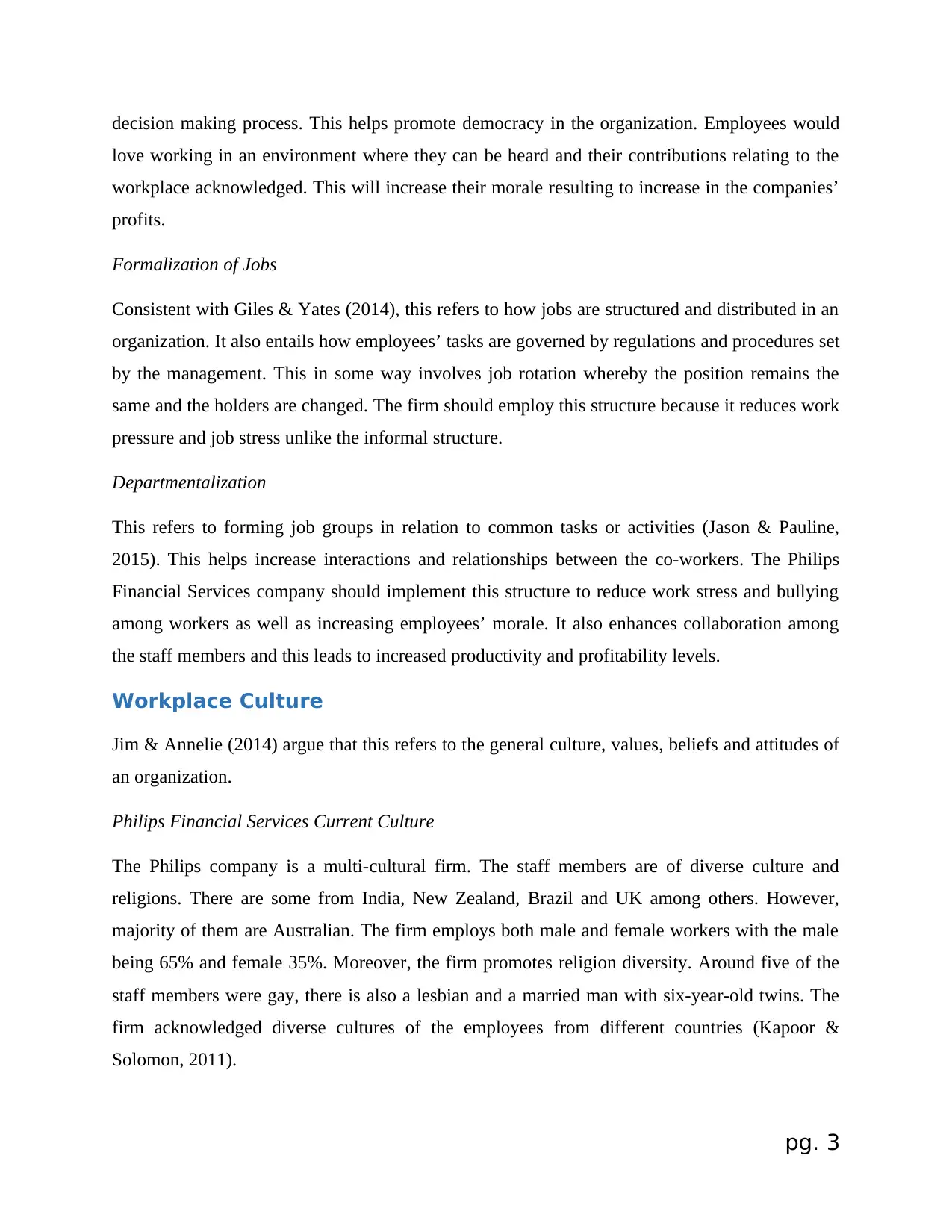
decision making process. This helps promote democracy in the organization. Employees would
love working in an environment where they can be heard and their contributions relating to the
workplace acknowledged. This will increase their morale resulting to increase in the companies’
profits.
Formalization of Jobs
Consistent with Giles & Yates (2014), this refers to how jobs are structured and distributed in an
organization. It also entails how employees’ tasks are governed by regulations and procedures set
by the management. This in some way involves job rotation whereby the position remains the
same and the holders are changed. The firm should employ this structure because it reduces work
pressure and job stress unlike the informal structure.
Departmentalization
This refers to forming job groups in relation to common tasks or activities (Jason & Pauline,
2015). This helps increase interactions and relationships between the co-workers. The Philips
Financial Services company should implement this structure to reduce work stress and bullying
among workers as well as increasing employees’ morale. It also enhances collaboration among
the staff members and this leads to increased productivity and profitability levels.
Workplace Culture
Jim & Annelie (2014) argue that this refers to the general culture, values, beliefs and attitudes of
an organization.
Philips Financial Services Current Culture
The Philips company is a multi-cultural firm. The staff members are of diverse culture and
religions. There are some from India, New Zealand, Brazil and UK among others. However,
majority of them are Australian. The firm employs both male and female workers with the male
being 65% and female 35%. Moreover, the firm promotes religion diversity. Around five of the
staff members were gay, there is also a lesbian and a married man with six-year-old twins. The
firm acknowledged diverse cultures of the employees from different countries (Kapoor &
Solomon, 2011).
pg. 3
love working in an environment where they can be heard and their contributions relating to the
workplace acknowledged. This will increase their morale resulting to increase in the companies’
profits.
Formalization of Jobs
Consistent with Giles & Yates (2014), this refers to how jobs are structured and distributed in an
organization. It also entails how employees’ tasks are governed by regulations and procedures set
by the management. This in some way involves job rotation whereby the position remains the
same and the holders are changed. The firm should employ this structure because it reduces work
pressure and job stress unlike the informal structure.
Departmentalization
This refers to forming job groups in relation to common tasks or activities (Jason & Pauline,
2015). This helps increase interactions and relationships between the co-workers. The Philips
Financial Services company should implement this structure to reduce work stress and bullying
among workers as well as increasing employees’ morale. It also enhances collaboration among
the staff members and this leads to increased productivity and profitability levels.
Workplace Culture
Jim & Annelie (2014) argue that this refers to the general culture, values, beliefs and attitudes of
an organization.
Philips Financial Services Current Culture
The Philips company is a multi-cultural firm. The staff members are of diverse culture and
religions. There are some from India, New Zealand, Brazil and UK among others. However,
majority of them are Australian. The firm employs both male and female workers with the male
being 65% and female 35%. Moreover, the firm promotes religion diversity. Around five of the
staff members were gay, there is also a lesbian and a married man with six-year-old twins. The
firm acknowledged diverse cultures of the employees from different countries (Kapoor &
Solomon, 2011).
pg. 3
⊘ This is a preview!⊘
Do you want full access?
Subscribe today to unlock all pages.

Trusted by 1+ million students worldwide
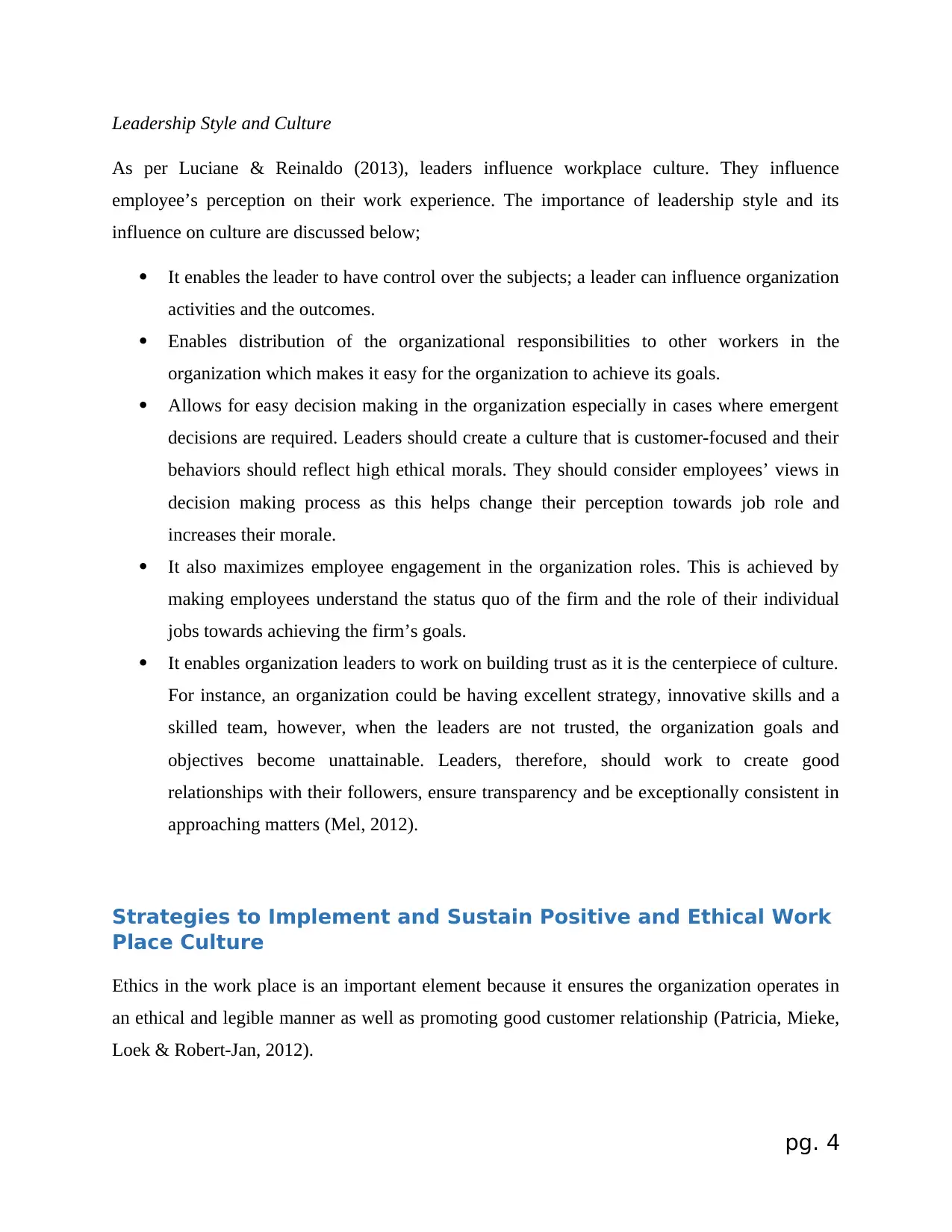
Leadership Style and Culture
As per Luciane & Reinaldo (2013), leaders influence workplace culture. They influence
employee’s perception on their work experience. The importance of leadership style and its
influence on culture are discussed below;
It enables the leader to have control over the subjects; a leader can influence organization
activities and the outcomes.
Enables distribution of the organizational responsibilities to other workers in the
organization which makes it easy for the organization to achieve its goals.
Allows for easy decision making in the organization especially in cases where emergent
decisions are required. Leaders should create a culture that is customer-focused and their
behaviors should reflect high ethical morals. They should consider employees’ views in
decision making process as this helps change their perception towards job role and
increases their morale.
It also maximizes employee engagement in the organization roles. This is achieved by
making employees understand the status quo of the firm and the role of their individual
jobs towards achieving the firm’s goals.
It enables organization leaders to work on building trust as it is the centerpiece of culture.
For instance, an organization could be having excellent strategy, innovative skills and a
skilled team, however, when the leaders are not trusted, the organization goals and
objectives become unattainable. Leaders, therefore, should work to create good
relationships with their followers, ensure transparency and be exceptionally consistent in
approaching matters (Mel, 2012).
Strategies to Implement and Sustain Positive and Ethical Work
Place Culture
Ethics in the work place is an important element because it ensures the organization operates in
an ethical and legible manner as well as promoting good customer relationship (Patricia, Mieke,
Loek & Robert‐Jan, 2012).
pg. 4
As per Luciane & Reinaldo (2013), leaders influence workplace culture. They influence
employee’s perception on their work experience. The importance of leadership style and its
influence on culture are discussed below;
It enables the leader to have control over the subjects; a leader can influence organization
activities and the outcomes.
Enables distribution of the organizational responsibilities to other workers in the
organization which makes it easy for the organization to achieve its goals.
Allows for easy decision making in the organization especially in cases where emergent
decisions are required. Leaders should create a culture that is customer-focused and their
behaviors should reflect high ethical morals. They should consider employees’ views in
decision making process as this helps change their perception towards job role and
increases their morale.
It also maximizes employee engagement in the organization roles. This is achieved by
making employees understand the status quo of the firm and the role of their individual
jobs towards achieving the firm’s goals.
It enables organization leaders to work on building trust as it is the centerpiece of culture.
For instance, an organization could be having excellent strategy, innovative skills and a
skilled team, however, when the leaders are not trusted, the organization goals and
objectives become unattainable. Leaders, therefore, should work to create good
relationships with their followers, ensure transparency and be exceptionally consistent in
approaching matters (Mel, 2012).
Strategies to Implement and Sustain Positive and Ethical Work
Place Culture
Ethics in the work place is an important element because it ensures the organization operates in
an ethical and legible manner as well as promoting good customer relationship (Patricia, Mieke,
Loek & Robert‐Jan, 2012).
pg. 4
Paraphrase This Document
Need a fresh take? Get an instant paraphrase of this document with our AI Paraphraser
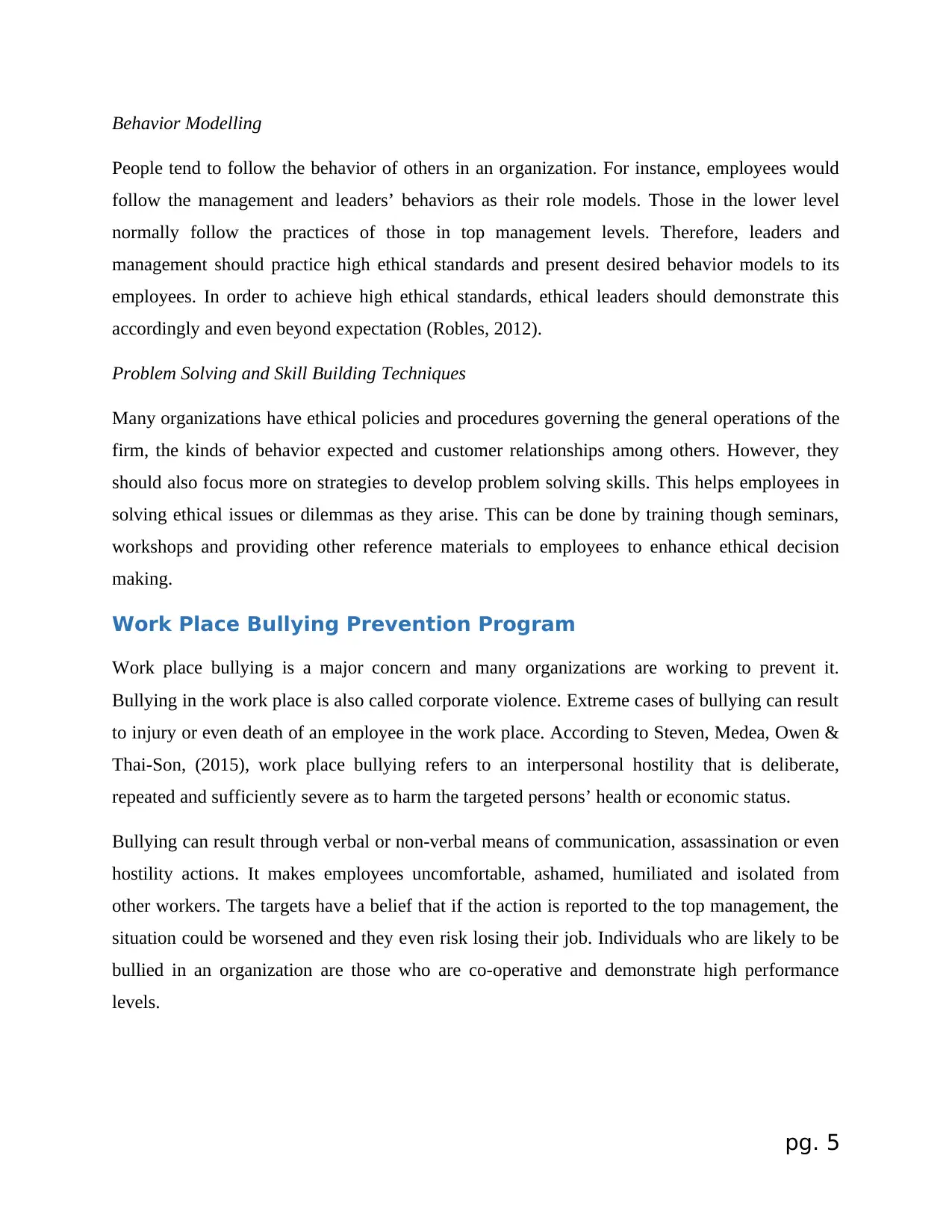
Behavior Modelling
People tend to follow the behavior of others in an organization. For instance, employees would
follow the management and leaders’ behaviors as their role models. Those in the lower level
normally follow the practices of those in top management levels. Therefore, leaders and
management should practice high ethical standards and present desired behavior models to its
employees. In order to achieve high ethical standards, ethical leaders should demonstrate this
accordingly and even beyond expectation (Robles, 2012).
Problem Solving and Skill Building Techniques
Many organizations have ethical policies and procedures governing the general operations of the
firm, the kinds of behavior expected and customer relationships among others. However, they
should also focus more on strategies to develop problem solving skills. This helps employees in
solving ethical issues or dilemmas as they arise. This can be done by training though seminars,
workshops and providing other reference materials to employees to enhance ethical decision
making.
Work Place Bullying Prevention Program
Work place bullying is a major concern and many organizations are working to prevent it.
Bullying in the work place is also called corporate violence. Extreme cases of bullying can result
to injury or even death of an employee in the work place. According to Steven, Medea, Owen &
Thai-Son, (2015), work place bullying refers to an interpersonal hostility that is deliberate,
repeated and sufficiently severe as to harm the targeted persons’ health or economic status.
Bullying can result through verbal or non-verbal means of communication, assassination or even
hostility actions. It makes employees uncomfortable, ashamed, humiliated and isolated from
other workers. The targets have a belief that if the action is reported to the top management, the
situation could be worsened and they even risk losing their job. Individuals who are likely to be
bullied in an organization are those who are co-operative and demonstrate high performance
levels.
pg. 5
People tend to follow the behavior of others in an organization. For instance, employees would
follow the management and leaders’ behaviors as their role models. Those in the lower level
normally follow the practices of those in top management levels. Therefore, leaders and
management should practice high ethical standards and present desired behavior models to its
employees. In order to achieve high ethical standards, ethical leaders should demonstrate this
accordingly and even beyond expectation (Robles, 2012).
Problem Solving and Skill Building Techniques
Many organizations have ethical policies and procedures governing the general operations of the
firm, the kinds of behavior expected and customer relationships among others. However, they
should also focus more on strategies to develop problem solving skills. This helps employees in
solving ethical issues or dilemmas as they arise. This can be done by training though seminars,
workshops and providing other reference materials to employees to enhance ethical decision
making.
Work Place Bullying Prevention Program
Work place bullying is a major concern and many organizations are working to prevent it.
Bullying in the work place is also called corporate violence. Extreme cases of bullying can result
to injury or even death of an employee in the work place. According to Steven, Medea, Owen &
Thai-Son, (2015), work place bullying refers to an interpersonal hostility that is deliberate,
repeated and sufficiently severe as to harm the targeted persons’ health or economic status.
Bullying can result through verbal or non-verbal means of communication, assassination or even
hostility actions. It makes employees uncomfortable, ashamed, humiliated and isolated from
other workers. The targets have a belief that if the action is reported to the top management, the
situation could be worsened and they even risk losing their job. Individuals who are likely to be
bullied in an organization are those who are co-operative and demonstrate high performance
levels.
pg. 5
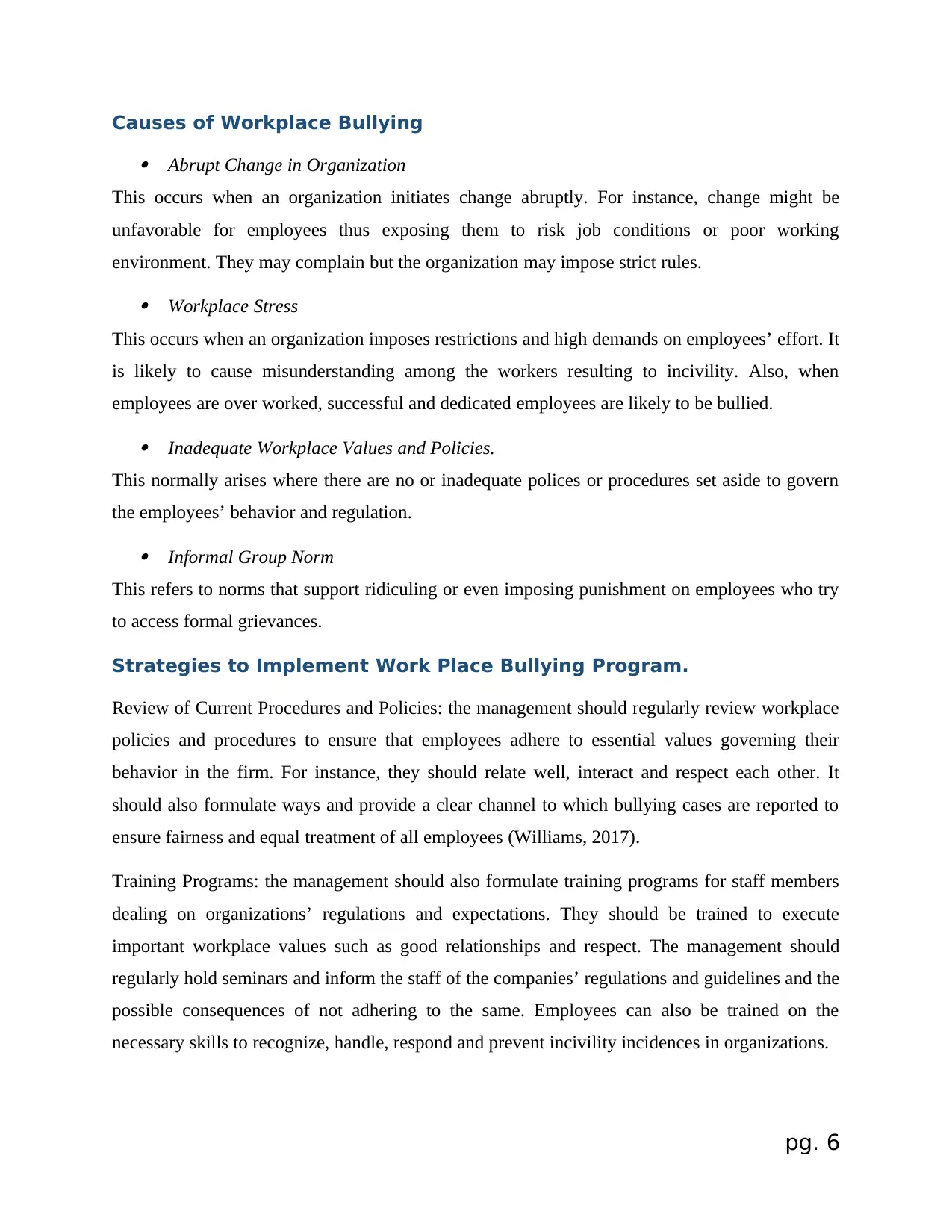
Causes of Workplace Bullying Abrupt Change in Organization
This occurs when an organization initiates change abruptly. For instance, change might be
unfavorable for employees thus exposing them to risk job conditions or poor working
environment. They may complain but the organization may impose strict rules. Workplace Stress
This occurs when an organization imposes restrictions and high demands on employees’ effort. It
is likely to cause misunderstanding among the workers resulting to incivility. Also, when
employees are over worked, successful and dedicated employees are likely to be bullied. Inadequate Workplace Values and Policies.
This normally arises where there are no or inadequate polices or procedures set aside to govern
the employees’ behavior and regulation. Informal Group Norm
This refers to norms that support ridiculing or even imposing punishment on employees who try
to access formal grievances.
Strategies to Implement Work Place Bullying Program.
Review of Current Procedures and Policies: the management should regularly review workplace
policies and procedures to ensure that employees adhere to essential values governing their
behavior in the firm. For instance, they should relate well, interact and respect each other. It
should also formulate ways and provide a clear channel to which bullying cases are reported to
ensure fairness and equal treatment of all employees (Williams, 2017).
Training Programs: the management should also formulate training programs for staff members
dealing on organizations’ regulations and expectations. They should be trained to execute
important workplace values such as good relationships and respect. The management should
regularly hold seminars and inform the staff of the companies’ regulations and guidelines and the
possible consequences of not adhering to the same. Employees can also be trained on the
necessary skills to recognize, handle, respond and prevent incivility incidences in organizations.
pg. 6
This occurs when an organization initiates change abruptly. For instance, change might be
unfavorable for employees thus exposing them to risk job conditions or poor working
environment. They may complain but the organization may impose strict rules. Workplace Stress
This occurs when an organization imposes restrictions and high demands on employees’ effort. It
is likely to cause misunderstanding among the workers resulting to incivility. Also, when
employees are over worked, successful and dedicated employees are likely to be bullied. Inadequate Workplace Values and Policies.
This normally arises where there are no or inadequate polices or procedures set aside to govern
the employees’ behavior and regulation. Informal Group Norm
This refers to norms that support ridiculing or even imposing punishment on employees who try
to access formal grievances.
Strategies to Implement Work Place Bullying Program.
Review of Current Procedures and Policies: the management should regularly review workplace
policies and procedures to ensure that employees adhere to essential values governing their
behavior in the firm. For instance, they should relate well, interact and respect each other. It
should also formulate ways and provide a clear channel to which bullying cases are reported to
ensure fairness and equal treatment of all employees (Williams, 2017).
Training Programs: the management should also formulate training programs for staff members
dealing on organizations’ regulations and expectations. They should be trained to execute
important workplace values such as good relationships and respect. The management should
regularly hold seminars and inform the staff of the companies’ regulations and guidelines and the
possible consequences of not adhering to the same. Employees can also be trained on the
necessary skills to recognize, handle, respond and prevent incivility incidences in organizations.
pg. 6
⊘ This is a preview!⊘
Do you want full access?
Subscribe today to unlock all pages.

Trusted by 1+ million students worldwide
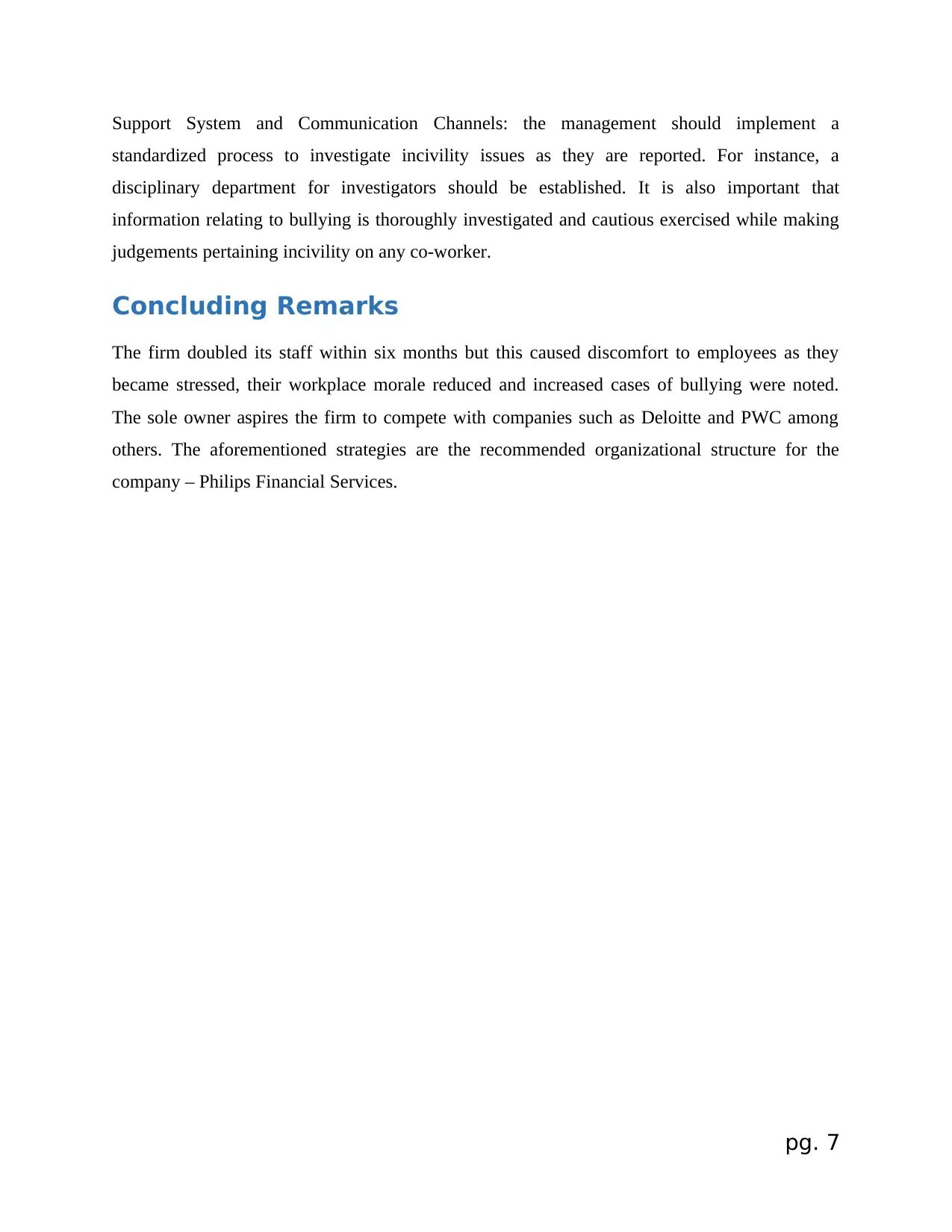
Support System and Communication Channels: the management should implement a
standardized process to investigate incivility issues as they are reported. For instance, a
disciplinary department for investigators should be established. It is also important that
information relating to bullying is thoroughly investigated and cautious exercised while making
judgements pertaining incivility on any co-worker.
Concluding Remarks
The firm doubled its staff within six months but this caused discomfort to employees as they
became stressed, their workplace morale reduced and increased cases of bullying were noted.
The sole owner aspires the firm to compete with companies such as Deloitte and PWC among
others. The aforementioned strategies are the recommended organizational structure for the
company – Philips Financial Services.
pg. 7
standardized process to investigate incivility issues as they are reported. For instance, a
disciplinary department for investigators should be established. It is also important that
information relating to bullying is thoroughly investigated and cautious exercised while making
judgements pertaining incivility on any co-worker.
Concluding Remarks
The firm doubled its staff within six months but this caused discomfort to employees as they
became stressed, their workplace morale reduced and increased cases of bullying were noted.
The sole owner aspires the firm to compete with companies such as Deloitte and PWC among
others. The aforementioned strategies are the recommended organizational structure for the
company – Philips Financial Services.
pg. 7
Paraphrase This Document
Need a fresh take? Get an instant paraphrase of this document with our AI Paraphraser
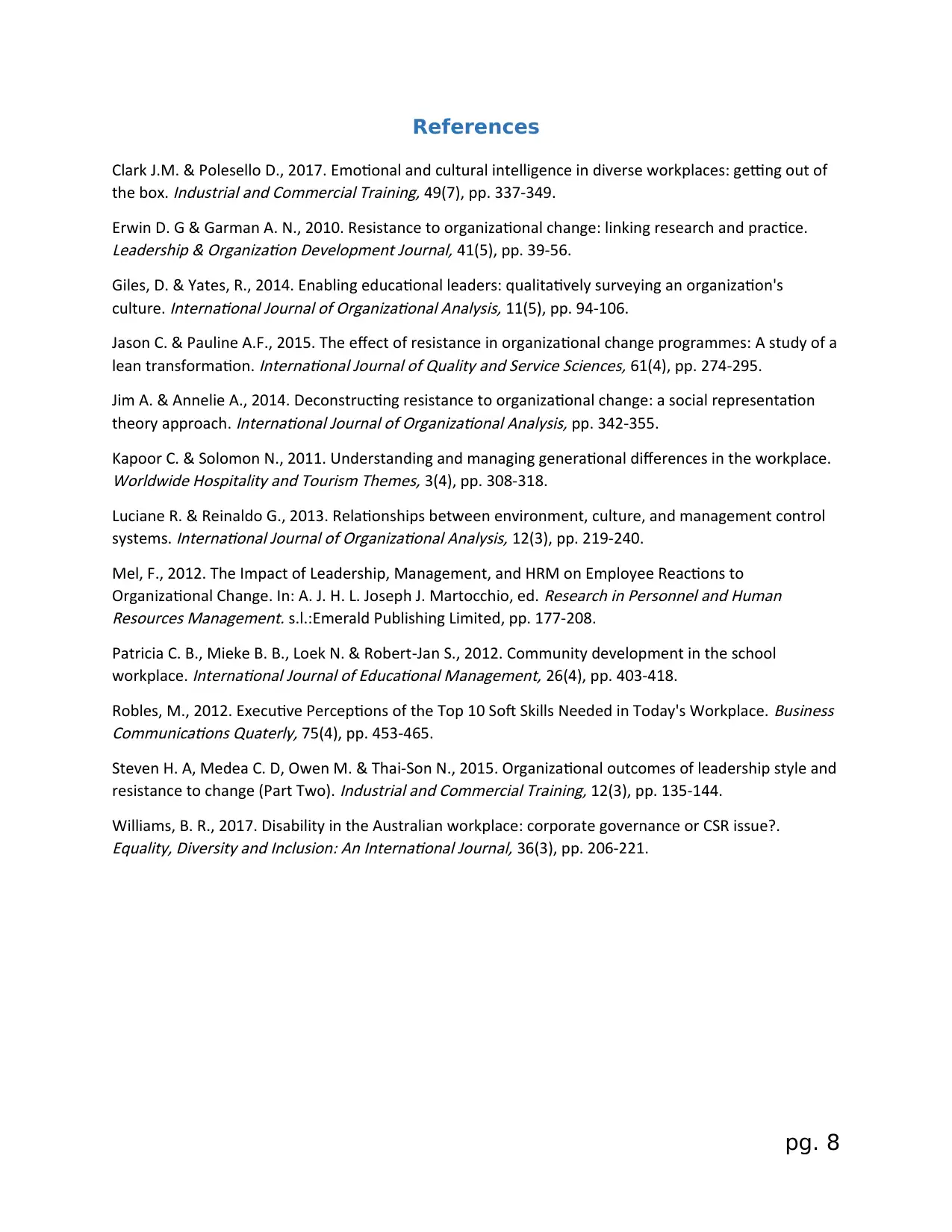
References
Clark J.M. & Polesello D., 2017. Emotional and cultural intelligence in diverse workplaces: getting out of
the box.
Industrial and Commercial Training, 49(7), pp. 337-349.
Erwin D. G & Garman A. N., 2010. Resistance to organizational change: linking research and practice.Leadership & Organization Development Journal, 41(5), pp. 39-56.
Giles, D. & Yates, R., 2014. Enabling educational leaders: qualitatively surveying an organization's
culture.
International Journal of Organizational Analysis, 11(5), pp. 94-106.
Jason C. & Pauline A.F., 2015. The effect of resistance in organizational change programmes: A study of a
lean transformation.
International Journal of Quality and Service Sciences, 61(4), pp. 274-295.
Jim A. & Annelie A., 2014. Deconstructing resistance to organizational change: a social representation
theory approach.
International Journal of Organizational Analysis, pp. 342-355.
Kapoor C. & Solomon N., 2011. Understanding and managing generational differences in the workplace.Worldwide Hospitality and Tourism Themes, 3(4), pp. 308-318.
Luciane R. & Reinaldo G., 2013. Relationships between environment, culture, and management control
systems.
International Journal of Organizational Analysis, 12(3), pp. 219-240.
Mel, F., 2012. The Impact of Leadership, Management, and HRM on Employee Reactions to
Organizational Change. In: A. J. H. L. Joseph J. Martocchio, ed.
Research in Personnel and Human
Resources Management. s.l.:Emerald Publishing Limited, pp. 177-208.
Patricia C. B., Mieke B. B., Loek N. & Robert-Jan S., 2012. Community development in the school
workplace.
International Journal of Educational Management, 26(4), pp. 403-418.
Robles, M., 2012. Executive Perceptions of the Top 10 Soft Skills Needed in Today's Workplace.
Business
Communications Quaterly, 75(4), pp. 453-465.
Steven H. A, Medea C. D, Owen M. & Thai-Son N., 2015. Organizational outcomes of leadership style and
resistance to change (Part Two).
Industrial and Commercial Training, 12(3), pp. 135-144.
Williams, B. R., 2017. Disability in the Australian workplace: corporate governance or CSR issue?.Equality, Diversity and Inclusion: An International Journal, 36(3), pp. 206-221.
pg. 8
Clark J.M. & Polesello D., 2017. Emotional and cultural intelligence in diverse workplaces: getting out of
the box.
Industrial and Commercial Training, 49(7), pp. 337-349.
Erwin D. G & Garman A. N., 2010. Resistance to organizational change: linking research and practice.Leadership & Organization Development Journal, 41(5), pp. 39-56.
Giles, D. & Yates, R., 2014. Enabling educational leaders: qualitatively surveying an organization's
culture.
International Journal of Organizational Analysis, 11(5), pp. 94-106.
Jason C. & Pauline A.F., 2015. The effect of resistance in organizational change programmes: A study of a
lean transformation.
International Journal of Quality and Service Sciences, 61(4), pp. 274-295.
Jim A. & Annelie A., 2014. Deconstructing resistance to organizational change: a social representation
theory approach.
International Journal of Organizational Analysis, pp. 342-355.
Kapoor C. & Solomon N., 2011. Understanding and managing generational differences in the workplace.Worldwide Hospitality and Tourism Themes, 3(4), pp. 308-318.
Luciane R. & Reinaldo G., 2013. Relationships between environment, culture, and management control
systems.
International Journal of Organizational Analysis, 12(3), pp. 219-240.
Mel, F., 2012. The Impact of Leadership, Management, and HRM on Employee Reactions to
Organizational Change. In: A. J. H. L. Joseph J. Martocchio, ed.
Research in Personnel and Human
Resources Management. s.l.:Emerald Publishing Limited, pp. 177-208.
Patricia C. B., Mieke B. B., Loek N. & Robert-Jan S., 2012. Community development in the school
workplace.
International Journal of Educational Management, 26(4), pp. 403-418.
Robles, M., 2012. Executive Perceptions of the Top 10 Soft Skills Needed in Today's Workplace.
Business
Communications Quaterly, 75(4), pp. 453-465.
Steven H. A, Medea C. D, Owen M. & Thai-Son N., 2015. Organizational outcomes of leadership style and
resistance to change (Part Two).
Industrial and Commercial Training, 12(3), pp. 135-144.
Williams, B. R., 2017. Disability in the Australian workplace: corporate governance or CSR issue?.Equality, Diversity and Inclusion: An International Journal, 36(3), pp. 206-221.
pg. 8
1 out of 8
Related Documents
Your All-in-One AI-Powered Toolkit for Academic Success.
+13062052269
info@desklib.com
Available 24*7 on WhatsApp / Email
![[object Object]](/_next/static/media/star-bottom.7253800d.svg)
Unlock your academic potential
Copyright © 2020–2025 A2Z Services. All Rights Reserved. Developed and managed by ZUCOL.





